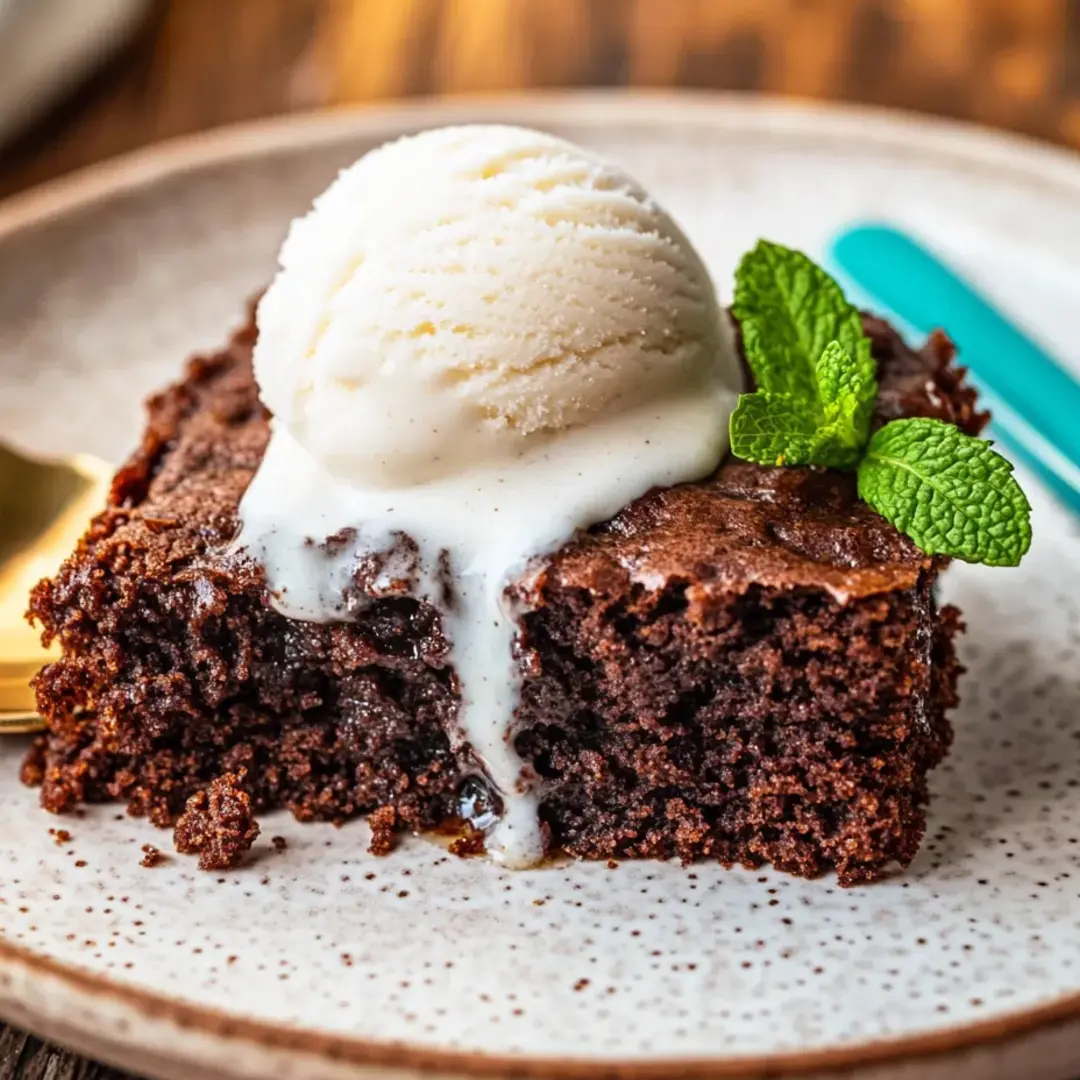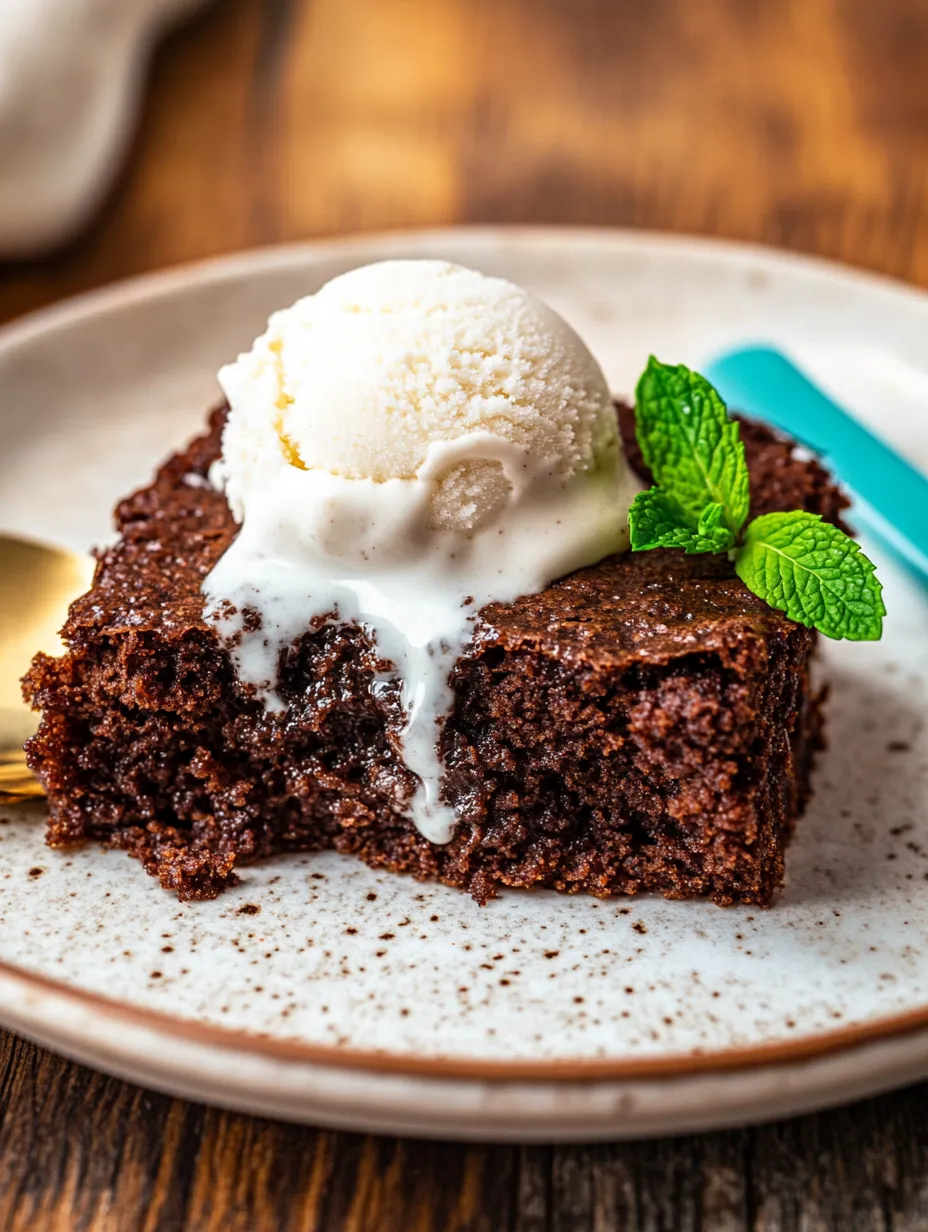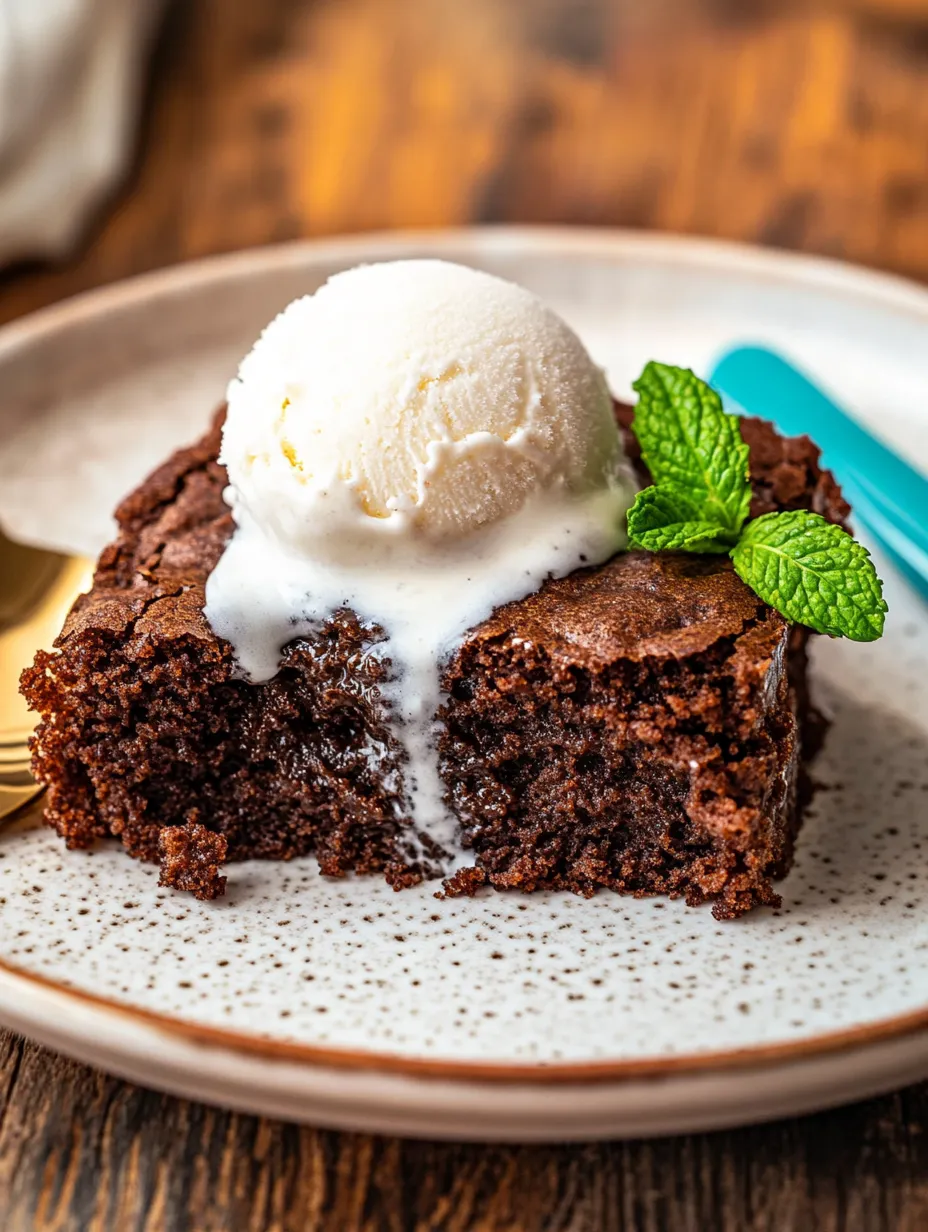 Pin it
Pin it
This Gingerbread Pudding Cake transforms classic holiday flavors into a decadent dessert that bridges the gap between cake and pudding. Each spoonful delivers a beautiful contrast of textures – a lightly crisp, caramelized exterior yielding to a warm, pudding-like center infused with molasses and aromatic spices. Unlike traditional gingerbread that can sometimes be dry or dense, this self-saucing wonder creates its own rich butterscotch-like sauce as it bakes, ensuring every bite remains moist and tender. The deep molasses flavor, brightened with warm ginger, cinnamon, and nutmeg, evokes nostalgic holiday memories while creating new ones around your table. Perfect for cozy winter gatherings or holiday celebrations, this effortless yet impressive dessert embodies the essence of comfort food at its seasonal best.
I discovered this recipe during a snowy December evening when I craved something gingerbread-flavored but wanted more comfort and warmth than a traditional cookie or cake could provide. After serving it at our annual holiday gathering, my brother-in-law (who typically declines dessert) not only accepted a portion but returned for seconds and then asked if he could take some home! My neighbor, who considers herself a gingerbread connoisseur, declared it "Christmas in a bowl" and now requests it as her birthday dessert despite having a January birthday. What began as a cozy experiment has become our family's most anticipated holiday tradition.
Ingredients
- 1/4 cup unsalted butter, melted: Creates richness and helps form the caramelized exterior. Using unsalted allows better control of the final flavor balance.
- 1/2 cup molasses: Provides that distinctive, deep gingerbread flavor. Blackstrap molasses offers the most robust flavor, but regular molasses works beautifully too.
- 1/4 cup brown sugar, packed: Adds caramel notes and moisture to the cake portion. Dark brown sugar provides the most pronounced molasses undertones.
- 1 large egg: Provides structure and richness. Room temperature eggs incorporate more easily into the batter.
- 1 1/2 cups all-purpose flour: Forms the cake's foundation. Measuring by weight rather than volume ensures the most accurate results.
- 1 teaspoon baking soda: Creates the proper rise and texture in reaction with the acidic molasses. Always check for freshness before using.
- 2 teaspoons ground ginger: The star spice that gives gingerbread its distinctive warm, slightly peppery character. Freshly ground provides the most vibrant flavor.
- 1 teaspoon ground cinnamon: Adds sweet warmth that complements the ginger perfectly. Vietnamese or Ceylon cinnamon offers the most complex flavor profile.
- 1/4 teaspoon ground nutmeg: Contributes subtle aromatic notes that round out the spice blend. Freshly grated nutmeg is considerably more fragrant than pre-ground.
- 1/4 teaspoon salt: Balances the sweetness and enhances all the other flavors. Even this small amount makes a significant difference in the final taste.
- 1/2 cup hot water: Activates the baking soda and helps create the pudding-like consistency. The water's temperature is important for proper chemical reactions.
- For the topping:
- 3/4 cup brown sugar, packed: Creates the magical self-saucing effect as it melts into the hot water. The sugar caramelizes around the edges for that distinctive texture.
- 1 1/4 cups hot water: Transforms the topping into a rich sauce that infuses the cake as it bakes. The water should be hot but not boiling.
- 2 tablespoons butter, melted: Enriches the sauce and contributes to the caramelization around the edges and top of the cake.
I'm particularly passionate about the molasses in this recipe. After experimenting with different varieties, I've found that a robust, full-flavored molasses (not blackstrap, which can be too bitter) creates the perfect backbone of flavor. The molasses not only contributes that distinctive gingerbread taste but also reacts with the baking soda to create the ideal texture – neither too dense nor too airy. This moisture-rich ingredient is what transforms an ordinary spice cake into something truly memorable.
 Pin it
Pin it
Step-by-Step Instructions
- Step 1:
- Begin by preheating your oven to a moderate 350°F (175°C). This temperature allows the cake to bake evenly while giving the sauce time to develop properly. Position the rack in the middle of the oven for even heat distribution.
- Step 2:
- Prepare an 8x8-inch square baking dish by lightly greasing it with butter or cooking spray. The square shape ensures proper thickness and even baking, while the greasing prevents any sticking, especially around the caramelized edges.
- Step 3:
- In a medium mixing bowl, combine the melted butter, molasses, and brown sugar for the cake batter. Whisk until smooth and the sugar has begun to dissolve into the warm butter. The mixture should be glossy and uniform in color.
- Step 4:
- Add the egg to the molasses mixture and whisk vigorously until fully incorporated. The egg provides structure and richness to the cake layer. Make sure it's fully blended to ensure even texture in the finished cake.
- Step 5:
- In a separate bowl, whisk together the flour, baking soda, ground ginger, cinnamon, nutmeg, and salt. This dry mixture should be thoroughly combined to ensure the spices and leavening agent are evenly distributed throughout the cake.
- Step 6:
- Gradually add the dry ingredients to the wet ingredients, alternating with additions of the hot water. Begin and end with the flour mixture, incorporating each addition just until combined. This method prevents overmixing while ensuring proper ingredient integration.
- Step 7:
- Stir just until the batter is smooth and no dry pockets remain. The batter will be relatively thin compared to traditional cake batters – this is expected and helps create the pudding-like quality. Avoid overmixing, which can develop gluten and make the cake tough.
- Step 8:
- Pour the batter into the prepared baking dish, spreading it evenly to the corners. The batter should level itself, but you can give the pan a gentle tap on the counter to release any air bubbles and ensure an even layer.
- Step 9:
- In a separate bowl or measuring cup, combine the brown sugar for the topping with the melted butter, stirring until the sugar is moistened and clumping slightly. This mixture will create the caramelized top and contribute to the sauce formation.
- Step 10:
- Sprinkle this brown sugar mixture evenly over the top of the cake batter, covering the entire surface. It may seem like a lot of sugar, but this is what creates the magical self-saucing effect and caramelized exterior.
- Step 11:
- Carefully pour the hot water for the topping over the brown sugar layer. Do not stir – this separate layering is crucial to creating the pudding effect. The hot water will seem like too much liquid, but it's essential for sauce development.
- Step 12:
- Gently transfer the filled baking dish to the preheated oven, taking care not to splash or disturb the layers. The distinct layers at this stage will transform during baking into the pudding cake's signature textures.
- Step 13:
- Bake for 35-40 minutes, until the top is set and the edges are deeply caramelized. The center should still have a slight jiggle when the pan is gently shaken – this indicates the perfect pudding consistency beneath the cake layer.
- Step 14:
- Remove from the oven and allow to cool for 15-20 minutes before serving. This cooling period allows the sauce to thicken slightly and the flavors to meld while still serving the dessert warm.
- Step 15:
- Serve warm in bowls, making sure to spoon some of the sauce from the bottom of the pan over each portion. A scoop of vanilla ice cream or lightly sweetened whipped cream makes the perfect accompaniment, melting slightly into the warm cake for additional sauce.
 Pin it
Pin it
The Magic of Self-Saucing Pudding Cakes
What makes this gingerbread pudding cake so special is the fascinating chemistry behind its creation. This dessert belongs to a category known as "self-saucing puddings" – a brilliant baking technique where a single mixture transforms during baking into distinct layers of cake and sauce.
The science lies in the careful layering before baking: cake batter on the bottom, dry sugar mixture in the middle, and hot water poured over the top. During baking, the water and sugar create a rich sauce that sinks beneath the cake batter, which simultaneously rises to the top and sets. The result is a perfectly textured cake sitting atop a luscious, flavorful sauce – all from one pan with minimal effort.
The caramelization around the edges occurs as the sugar in contact with the hot pan transforms, creating those chewy, deeply flavored bits that contrast beautifully with the soft interior. It's a perfect example of how simple ingredients and techniques can create something that seems far more complex and impressive than the sum of its parts.
Perfect Holiday Pairings
This Gingerbread Pudding Cake pairs beautifully with complementary flavors that enhance its warm, spicy profile:
- Vanilla Bean Ice Cream: The classic pairing – the cold, creamy vanilla melts slightly into the warm cake, creating additional sauce while providing temperature and flavor contrast. Choose a high-quality ice cream with visible vanilla bean specks for the most luxurious experience.
- Maple Whipped Cream: Transform ordinary whipped cream by adding a tablespoon of pure maple syrup during whipping. The maple notes complement the molasses beautifully for a decidedly North American flavor profile.
- Brandied Hard Sauce: For an adults-only holiday treat, serve with traditional hard sauce (butter, powdered sugar, and a generous splash of brandy). The subtle fruity notes of the brandy highlight the cake's spices.
- Toffee Sauce: Double down on the caramel notes by serving with a warm toffee sauce drizzled over the top. The additional buttery richness creates an even more indulgent dessert experience.
For a spectacular presentation at holiday gatherings, set up a pudding cake bar with the warm cake and several topping options, allowing guests to create their perfect combination.
I learned the importance of water temperature through a disappointing early attempt at this recipe. Using room temperature water instead of hot water resulted in inadequate sauce development and improper layering. The hot water is crucial for beginning the dissolution of the sugar topping and creating the right conditions for the sauce to form properly during baking. Now I make sure the water is steaming hot (just below boiling) before pouring it over the top, which ensures perfect sauce development every time.
There's something magical about the way this Gingerbread Pudding Cake fills your home with the quintessential scents of the holiday season while it bakes. The warming aroma of ginger, cinnamon, and molasses creates an atmosphere of comfort and celebration that signals special moments are at hand. Whether served at a festive gathering or enjoyed curled up by the fire on a cold winter evening, this dessert embodies the spirit of holiday indulgence while remaining beautifully simple to prepare. The contrast of textures and depth of flavor creates a memorable finish to any meal, proving once again that some of the most cherished traditions begin in the kitchen.
Frequently Asked Questions
- → What makes this a 'pudding cake'?
- A pudding cake creates its own sauce while baking. The hot water and butter poured over the top before baking sinks to the bottom, creating a pudding-like sauce underneath while the top bakes into cake.
- → Can I make this ahead of time?
- Yes! Make it up to 2 days ahead and refrigerate. Reheat individual portions in the microwave for 20-30 seconds before serving, or reheat the entire cake covered with foil in a 300°F oven until warm.
- → Can I substitute the molasses?
- For a milder flavor, you can use half molasses and half maple syrup or honey. However, the molasses provides the classic gingerbread flavor, so substituting completely will change the character of the dessert.
- → Why do you only use the egg white instead of a whole egg?
- Using just the egg white helps keep the cake light and prevents it from becoming too dense, allowing the pudding layer to form properly underneath.
- → Can I make this without nuts?
- Absolutely! The pecans can be omitted entirely without affecting the recipe. If you want some texture, you could substitute with dried cranberries or crystallized ginger pieces.
